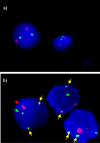The detection of t(14;18) in archival lymph nodes: development of a fluorescence in situ hybridization (FISH)-based method and evaluation by comparison with polymerase chain reaction
- PMID: 12876207
- PMCID: PMC1907328
- DOI: 10.1016/S1525-1578(10)60469-2
The detection of t(14;18) in archival lymph nodes: development of a fluorescence in situ hybridization (FISH)-based method and evaluation by comparison with polymerase chain reaction
Abstract
Fluorescence in situ hybridization (FISH) has been used to demonstrate the t(14;18) in up to 100% of follicular lymphoma (FL) cases, however, there is little reproducible data using fixed tissue. The aim was therefore to develop a robust FISH method for the demonstration of translocations in archival tissue. The technique was evaluated by comparison with multiplex polymerase chain reaction (PCR), capable of detecting the majority of known breakpoints. Twenty-eight paired frozen and fixed cases of FL and 20 reactive controls were analyzed. The t(14;18) was detected in 23 of 28 cases using PCR on frozen material and 8 of 20 in paraffin. Using FISH, 24 of 26 frozen and 26 of 28 paraffin cases had a demonstrable translocation. All 20 reactive nodes were negative for the t(14;18) by PCR. Using FISH, one of the reactive cases had occasional cells with a translocation FISH pattern, demonstrable in frozen and paraffin samples. This is consistent with the presence of the t(14;18), which is well described in normal individuals. Both PCR and FISH are highly effective for t(14;18) analysis in unfixed tissue. When only paraffin blocks are available, FISH is the method of choice, and a result was achieved in 100% of cases. The method is applicable to the retrospective analysis of a range of translocations.
Figures


Similar articles
-
Interphase fluorescence in situ hybridization is more sensitive than BIOMED-2 polymerase chain reaction protocol in detecting IGH-BCL2 rearrangement in both fixed and frozen lymph node with follicular lymphoma.Hum Pathol. 2007 Feb;38(2):365-72. doi: 10.1016/j.humpath.2006.08.022. Epub 2006 Nov 28. Hum Pathol. 2007. PMID: 17134735
-
FISH is superior to PCR in detecting t(14;18)(q32;q21)-IgH/bcl-2 in follicular lymphoma using paraffin-embedded tissue samples.Am J Clin Pathol. 2005 Sep;124(3):421-9. doi: 10.1309/BLH8-MMK8-5UBQ-4K6R. Am J Clin Pathol. 2005. PMID: 16191511
-
[Detection of t (14; 18) chromosomal translocation in paraffin-embedded tissues of follicular lymphoma and its clinical significance].Zhonghua Bing Li Xue Za Zhi. 2007 Sep;36(9):600-4. Zhonghua Bing Li Xue Za Zhi. 2007. PMID: 18070448 Chinese.
-
FISH and related techniques in the diagnosis of lymphoma.Cancer Surv. 1997;30:3-20. Cancer Surv. 1997. PMID: 9547983 Review.
-
The 14;18 translocation in European cases of follicular lymphoma: comparison of Southern blotting and the polymerase chain reaction.Br J Haematol. 1990 Sep;76(1):58-64. doi: 10.1111/j.1365-2141.1990.tb07836.x. Br J Haematol. 1990. PMID: 2223649 Review.
Cited by
-
A prospective clinicopathologic study of dose-modified CODOX-M/IVAC in patients with sporadic Burkitt lymphoma defined using cytogenetic and immunophenotypic criteria (MRC/NCRI LY10 trial).Blood. 2008 Sep 15;112(6):2248-60. doi: 10.1182/blood-2008-03-145128. Epub 2008 Jul 8. Blood. 2008. PMID: 18612102 Free PMC article. Clinical Trial.
-
The specificity of interphase FISH translocation probes in formalin fixed paraffin embedded tissue sections is readily assessed using automated staining and scoring of tissue microarrays constructed from murine xenografts.J Mol Histol. 2007 May;38(2):159-65. doi: 10.1007/s10735-006-9066-1. Epub 2006 Nov 9. J Mol Histol. 2007. PMID: 17094016
-
''Minor'' BCL2 breakpoints in follicular lymphoma: frequency and correlation with grade and disease presentation in 236 cases.J Mol Diagn. 2007 Sep;9(4):530-7. doi: 10.2353/jmoldx.2007.070038. Epub 2007 Jul 25. J Mol Diagn. 2007. PMID: 17652637 Free PMC article.
-
Detection of genetic alterations by immunoFISH analysis of whole cells extracted from routine biopsy material.J Mol Diagn. 2007 Sep;9(4):479-89. doi: 10.2353/jmoldx.2007.070041. Epub 2007 Aug 9. J Mol Diagn. 2007. PMID: 17690217 Free PMC article.
-
Non-Hodgkin lymphoma (NHL) subtypes defined by common translocations: utility of fluorescence in situ hybridization (FISH) in a case-control study.Leuk Res. 2010 Feb;34(2):190-5. doi: 10.1016/j.leukres.2009.05.007. Epub 2009 Jun 7. Leuk Res. 2010. PMID: 19505720 Free PMC article.
References
-
- Bloomfield CD, Arthur DC, Frizzera G, Levine EG, Peterson BA, Gajl-Peczalska KJ: Non-random chromosome abnormalities in lymphoma. Cancer Res 1983, 43:2975-2984 - PubMed
-
- Levine EG, Arthur DC, Frizzera G, Peterson BA, Hurd DD, Bloomfield CD: There are differences in cytogenetic abnormalities among histologic subtypes of the non-Hodgkin’s lymphomas. Blood 1985, 66:1414-1422 - PubMed
-
- Horsman DE, Gascoyne RD, Coupland RW, Coldman AJ, Adomat SA: Comparison of cytogenetic analysis, Southern analysis, and polymerase chain reaction for the detection of t(14;18) in follicular lymphoma. Am J Clin Pathol 1995, 103:472-478 - PubMed
-
- Johnson PW, Swinbank K, MacLennan S, Colomer D, Debuire B, Diss T, Gabert J, Gupta RK, Haynes A, Kneba M, Lee MS, Macintyre E, Mensink E, Moos M, Morgan GJ, Neri A, Johnson A, Reato G, Salles G, van’t Veer MB, Zehnder JL, Zucca E, Selby PJ, Cotter FE: Variability of polymerase chain reaction detection of the bcl-2-IgH translocation in an international multicentre study. Ann Oncol 1999, 10:1349-1354 - PubMed
Publication types
MeSH terms
LinkOut - more resources
Full Text Sources
Research Materials

